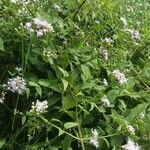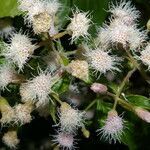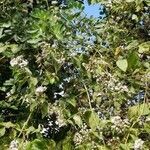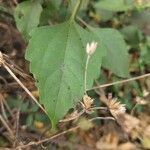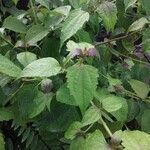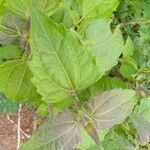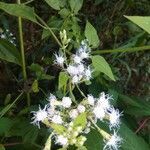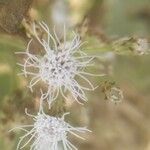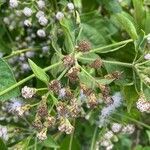Woody herbs or reclining shrubs to 3 m tall, much branched; stems reddish-brown, terete, finely striate, glabrous to hirsute. Leaves opposite; blades deltoid to rhombic-ovate, to 9 cm long and 5 cm wide, the base cuneate to subtruncate, the margins entire to serrate, the apex narrowly acuminate, the upper surface glabrous, rarely pubescent, the lower surface with numerous short-stalked to sessile red glands, the venation prominently trinervate from near the base; petioles to 2 cm long. Inflorescence a broad panicle to 8 cm wide and 4 cm high with corymbose branches, the ultimate branches usually pubescent. Heads ca. 1 cm high with ca. 25 florets; involucral bracts ca. 15, glabrous to sparsely pubescent, imbricate, with 3-4 costae, the outer bracts oblong with rounded to truncate apices, the inner bracts narrow, short-acute; receptacle naked; corolla white, lavender, pink or light bluish, ca. 6 mm long, tubular. Achenes ca. 4 mm long, prismatic, 4-5-ribbed, ribs with short bristles; pappus of ca. 30 scabrous bristles, ca. 6 mm long, the apical cells acute.
Erect or procumbent shrub 2–4 m high or vine climbing to 10 m; stems terete, strigose-pubescent. Leaves aromatic; petiole 10–30 mm long; lamina deltoid-ovate, 50–150 mm long, 20–60 (–80) mm wide, basally attenuate, serrate or entire in young leaves, acute, discolorous, adaxially sparsely pubescent, abaxially densely pubescent, glandular. Capitula with peduncles 10–30 mm long; involucre (8–) 9–10 mm long, 3–5 mm wide; involucral bracts 4–7-seriate, 2–12 mm long, glabrous to sparsely pubescent, with outer bracts ovate and inner bracts oblong with tips rounded to subacute; paleae absent. Florets 20–35, c. 5–6 mm long; corolla white, mauve, lavender, lilac, pink or purple. Achenes narrowly cylindrical, angular, c. 4 mm long, black, with (3) 4 or 5 white setulose ribs. Pappus bristles c. 5 mm long, fused at base, scabrid.
A diffuse, scrambling, aromatic shrub up to about 4 m, stems glabrous. Leaves opposite, ovate, up to 10 x 6 cm, gland-dotted and pubescent below, triplinerved, coarsely toothed or subentire, base broadly cuneate, apex acuminate; petiole about 1 cm long. Heads cylindric, c. 10 x 3 mm, many in congested corymbs, terminal and at the tips of short, stiff lateral branches. Involucral bracts in several series, outer much shorter than inner, which nearly equal the flowers, oblong, papery, straw-coloured, tips rounded, often darker. Flowers whitish or pale mauve. Achenes c. 5 mm long, narrowly subcylindric with 5 scabrid angles, black. Pappus of numerous scabrid bristles.
Perennials or subshrubs, mostly 80–250 cm. Stems erect or sprawling to subscandent, hispidulous to coarsely short-pilose. Petioles 5–20 mm. Leaf blades (3-nerved) narrowly lanceolate to deltate-lanceolate or ovate-lanceolate, 3–10 × 1–4 cm, margins coarsely dentate to subentire. Heads usually 5–50+ in (terminal or lateral) corymbiform arrays. Involucres cylindric, (7–)8–10 mm. Phyllaries in 4–6(–8) series, apices of the inner appressed, rounded to truncate (sometimes slightly white-petaloid or expanded). Corollas purplish to light blue to nearly white or slightly pinkish. 2n = 40, 60, 70.
Perennial shrub, 1.5-4.0 m high; sparingly to densely branched. Leaves opposite, triangular to elliptic, margins subentire to lobed. Capitula discoid; 10-40-flowered, in lax to dense corymbs; involucral bracts imbricate, ovate to lanceolate. Receptacle sometimes paleate. Corolla white; cylindrical, glandular, often hairy. Anthers with appendage margins sometimes crenulate. Style: branch appendages linear, sometimes papillose. Flowering time Jan.? Pappus of many capillary, scabrid bristles. Cypselae prismatic, with 5, rarely 3 ribs, setose, sometimes glandular.
A herb. It grows 1-2 m tall. It can be scrambling. It can form roots along the stems. The leaves are simple and can have teeth along the edge. They are 4.5-11 cm long by 2-5.5 cm wide. They are hairy on the top side. Underneath they are very hairy have small glands. The leaf stalks are 1-1.7 cm long. The flowers are in heads at the ends of the stalks or in the axils of leaves. The heads are 5 mm across. They are white, pink or purple. The bracts are green. The fruit is a nut. It is brown to black and 4 mm long.
Scrambling shrub, up to 4 m high. Involucral bracts in 5 or 6 series, outer much shorter than inner. Leaves opposite. Flowers whitish or pale mauve.
